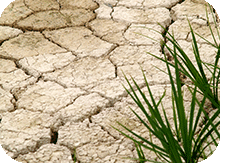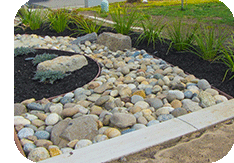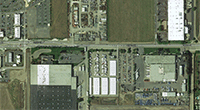|
|
Landscape Tips for Dealing with Drought
Author: Chad Kennedy, Landscape Architect, ASLA
 As the humidity drops and the air becomes progressively drier, moisture is extracted from soft tissues like a dry sponge. Attempting to sustain life, all non-essential tissue is discarded leaving only a skeleton of what once was, yet life continues. The delicate yet resilient tissue gradually succumbs, slowly shrivels, and eventually loses the ability to obtain the very water that would save it. Permanent wilting point has been reached; there is no chance of revival for the once vibrant and healthy tree. Though a bit dramatic, this is a very possible scenario when water is cut-off to a tree that is accustomed to frequent shallow watering. With current drought conditions in California, many cities and counties may be facing mandatory water restrictions and allocations, resulting in many of our landscapes facing serious reductions in water applications. As the humidity drops and the air becomes progressively drier, moisture is extracted from soft tissues like a dry sponge. Attempting to sustain life, all non-essential tissue is discarded leaving only a skeleton of what once was, yet life continues. The delicate yet resilient tissue gradually succumbs, slowly shrivels, and eventually loses the ability to obtain the very water that would save it. Permanent wilting point has been reached; there is no chance of revival for the once vibrant and healthy tree. Though a bit dramatic, this is a very possible scenario when water is cut-off to a tree that is accustomed to frequent shallow watering. With current drought conditions in California, many cities and counties may be facing mandatory water restrictions and allocations, resulting in many of our landscapes facing serious reductions in water applications.
Last month's article focused on plant water requirements and a plant index reference (WUCOLS) for designers and horticulturists. This article focuses specifically on tangible efforts and suggestions that, when implemented, will greatly help water conservation efforts while maintaining pleasant and enjoyable outdoor landscapes. These suggestions can be consolidated within two categories: irrigation adjustments and planting area adjustments.
Irrigation Adjustments
The key to wise irrigation of managed landscapes is efficiency! The simple truth is that our irrigation systems are governed by the least efficient area of the system. We irrigate until the dry spots are no longer dry, meaning all other areas that originally had adequate water are over watered. If the system is designed and installed with a focus on efficient coverage, water savings could be substantial. To put things into perspective, most traditional overhead sprinkler systems will only be 60-70% efficient at best. This leaves a great deal of room for improvement. Below are a few ideas for improving irrigation system efficiencies.
Replace traditional spray nozzles with high efficiency nozzles: There are many spray nozzles on the market now that spread water much more evenly across the landscape resulting in less puddles and fewer dry spots. Some nozzles will also apply water at slower rates giving water more time to infiltrate the soil, resulting in a reduction of wasteful runoff. Adjust irrigation system for head to head coverage: The water spray from one spray head should reach another head on the opposite side of the landscape area. As the distribution of water from the spray is not equal throughout the sprayed area, this will improve coverage and eliminate dry spots. Install a cost effective weather based controller: For very reasonable up-front cost, a weather based automatic controller can be installed with any irrigation system. These controllers (in tandem with a small weather sensor) measure the current temperature, solar radiation and rainfall. Then using this data and historic weather data from the local region, watering times are adjusted to match an estimated rate of water loss from the landscape (evapotranspiration). In essence, the controller estimates the amount of water needed to replenish soil moisture. Once installed and calibrated, these controllers are amazingly accurate at applying just the right amount of water to keep the landscape vibrant. The system shuts itself down during rain or freeze events and resumes when additional water is needed. This may be one of the most effective ways to conserve water in the landscape. Install or retrofit with drip / point source irrigation: Drip irrigation systems can be upwards of 90% efficient as the water is applied directly to the soil and root zone of the plant. There is less water loss due to wind, misting, evaporation and runoff. Typical irrigation systems can often be retrofitted easily with commercially available kits. Schedule irrigation cycles wisely: A simple way to conserve water is to schedule watering cycles to occur from dusk to dawn. The water will not evaporate as quickly and will have more time to filter into the soil. Depending on soil types and slopes, it is also effective to split irrigation times into several intervals. This allows water to seep into the soil gradually and reduces runoff that otherwise might occur.
Planting Area Adjustments 
Irrigation adjustments may be the most dramatic and immediate method of water conservation, but just as important are changes made to planting beds.
Choose appropriate plants: If the opportunity exists to replace plants or start fresh, plant selection can be an effective method of water conservation. Choose low water use plants (possibly, but not necessarily, native or drought tolerant). The main idea is to use as little water as possible to sustain an aesthetic landscape. There are many plants that do not require constantly moist soil in order to look amazing and flower prolifically. Wise selection of plants at the beginning will help avoid excessive attention and overwatering of unhappy plants. Choose plants that do well in the area, are hardy to the region, are matched to the pH of the soil, and are located per their solar exposure needs. Install 3" of organic mulch: Three inches of mulch applied to the surface of planting beds will limit the amount of evaporation from the surface and will keep soils moist. As a plus, the mulch will also inhibit the growth of weeds. Though inert mulches are also effective, the use of organic mulch will add nutrients to the soil as it breaks down, will hold more moisture, will improve the levels of organic material, and in turn, enhance soil buffering capacities. Use inert materials in the landscape: The use of boulders, cobbles and gravels can be an attractive way to limit the amount of living landscape requiring irrigation. Less area to irrigate equals water savings. Irrigate less frequently (yes, it is okay!): Most landscapes are irrigated far too frequently. In most cases, trees need watering only a few times a month, shrubs once a week, and grass only a couple times a week. This may be true, however, the majority of landscapes have been trained to frequent watering routines and will need to be weaned from their dependency on shallow water availability. Starting now to slowly cut back the frequency of irrigation will stimulate downward growth of roots and help the plant weather better with deeper, infrequent watering and drier conditions.
Listed above are just a few suggestions for responsible use of water in the landscape. There are many ways to save water, and many other efforts that can be made to avoid catastrophic permanent wilting point scenarios while making the outdoor environments we enjoy more beautiful, more enjoyable, and more sustainable in the long run. Visit our website to read more articles and to learn more about the many facets of landscape architecture.
|
|
|
|
|
|
|
Funding Opportunities
Due date: 05/15/14
Run for Something Better - Childhood obesity is a serious nationwide health concern. ING RFSB is tackling the issue by helping kids become fit through free, school-based running programs. In partnership with the American Alliance for Health, Physical Education, Recreation and Dance (AAHPERD), ING RFSB awards a minimum of 50 grants (up to $2,500 each) annually to elementary and middle schools nationwide to establish school-based running programs or expand existing ones. For additional information on this and other funding opportunities, please visit our resource center.
|
|
|
|
|
Media Updates
Recently, small businesses seeking contracts
and Californians who want to work got a big
boost from high-speed rail. In February, the
Authority’s Board of Directors green lighted
negotiations with five California firms vying
for right-of-way engineering and surveying
contracts. Four of the five small businesses
are certified small businesses and two of
them have their headquarters in the Central
Valley. Learn More Here.

|
|
|
|
|
Project Updates
Valpico Road Improvements, Tracy, CA
 Staff are just wrapping up design for the second of two phases of improvements to Valpico Road in Tracy CA. Improvement plans included include planting and irrigation additions to medians and periphery landscape areas.
|
|
|
|
|
|
 As the humidity drops and the air becomes progressively drier, moisture is extracted from soft tissues like a dry sponge. Attempting to sustain life, all non-essential tissue is discarded leaving only a skeleton of what once was, yet life continues. The delicate yet resilient tissue gradually succumbs, slowly shrivels, and eventually loses the ability to obtain the very water that would save it. Permanent wilting point has been reached; there is no chance of revival for the once vibrant and healthy tree. Though a bit dramatic, this is a very possible scenario when water is cut-off to a tree that is accustomed to frequent shallow watering. With current drought conditions in California, many cities and counties may be facing mandatory water restrictions and allocations, resulting in many of our landscapes facing serious reductions in water applications.
As the humidity drops and the air becomes progressively drier, moisture is extracted from soft tissues like a dry sponge. Attempting to sustain life, all non-essential tissue is discarded leaving only a skeleton of what once was, yet life continues. The delicate yet resilient tissue gradually succumbs, slowly shrivels, and eventually loses the ability to obtain the very water that would save it. Permanent wilting point has been reached; there is no chance of revival for the once vibrant and healthy tree. Though a bit dramatic, this is a very possible scenario when water is cut-off to a tree that is accustomed to frequent shallow watering. With current drought conditions in California, many cities and counties may be facing mandatory water restrictions and allocations, resulting in many of our landscapes facing serious reductions in water applications.


